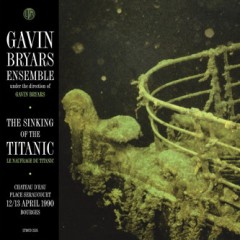Gavin Bryars - Sinking of the Titanic (Live Bourges) [1990/2009]
Gavin Bryars - Sinking of the Titanic (Live Bourges) [1990/2009]

1. Sinking of the Titanic 60:19 Clarinet (Bass Clarinet) – Roger Heaton Double Bass, Effects (Occationally With Octave Pedals) – Gavin Bryars Effects (Sound Effects) – Paul Bull Horn (Tenor Horn), Percussion (Woodblocks, Tam-tam), Keyboards (Korg M1) – Dave Smith Percussion (Tam-tam, Woodblocks), Bells, Marimba, Cymbal, Bass Drum – Martin Allen Viola – Alexander Balanescu, John Carney Repackaged reissue of a 1990 recording originally released by Les Disques du Crépuscule (TWI 922-2). This recording was made during a live performance in the Chateau D'Eau, Bourges (April 1990).
One of the two works for which composer Gavin Bryars is best known (the other being "Jesus' Blood Never Failed Me Yet"), his epochal "The Sinking of the Titanic" had been recorded three times in the 25 years since its creation. The first, for Brian Eno's Obscure label, was a landmark recording, but went swiftly out of print and became a much sought after collector's item, while the third, a relatively bland performance on Point, was widely distributed in the late '90s. In between, on the independent Belgian label Les Disques du Crepuscule, Bryars recorded what is possibly the definitive version though again, it is a difficult disc to locate. The composition is an attempt to metaphorically replicate the disaster of 1912 utilizing various elements associated with it, including the songs and hymns reported played on board that evening both before the iceberg was struck and as the ship was sinking. It's structured as an "open" piece, in that material subsequently uncovered may be added and information that becomes discredited may be discarded. The overall mood is, befittingly, sub-aqueous with long sustained tones on the strings, bass clarinet, and horn written to give the impression of sounds traveling great distances beneath the sea. This album was recorded in a large, abandoned water tower that adds enormously to its reverberative nature. The hymns used (particularly "Autumn," which modern listeners will recognize as being very similar to "Amazing Grace") take on a remarkably plaintive and ethereal character as the image of an undersea orchestra takes form. Bryars also incorporates taped narration from survivors and various underwater sounds, including the forlorn pinging of sonar, carrying the enormous and melancholy weight of searchers for the wreckage. Indeed, much of the great success of this work is its combination of minimalist compositional technique, the emotional impact of the hymns, and the scientific examination of the event from a distance over time. Always in the background is Bryars' romantic notion of the sounds of the drowning orchestra still reverberating beneath the waves. The Sinking of the Titanic is arguably one of the signal compositions of the 20th century and an extraordinarily beautiful work. While the performance on the Point label is serviceable, the interested listener is well advised to search out either this recording or the original on Obscure. ---Brian Olewnick, AllMusic Review
What began in 1969 as an attempt to find the musical equivalent of a work of conceptual art is now established as one of the classics of British experimental music. Gavin Bryars made his first performing version of The Sinking of the Titanic three years after that initial sketch, and has regularly returned to the indeterminate score ever since. This year's centenary of the tragedy on which the piece is founded has prompted him to go back to it once again, with his own ensemble and the experimental turntablist Philip Jeck, and specially commissioned visuals from film-maker Bill Morrison and multimedia artist Laurie Olinder.
Bryars's starting point was the eye-witness report that the Titanic's dance band continued to play as the ship sank, and that the hymn Autumn was the last thing to be heard before it disappeared. Fragments of the hymn and transformations of it form the musical basis, while other sound material – some musical, some documentary – is added to the collage. The first realisation was scored for ensemble and tape; the latest 70-minute incarnation derives essentially from the version on which Bryars and Jeck collaborated and recorded in the 1990s. Jeck's sampled sounds provide an aural backdrop, sometimes brooding and hypnotic, sometimes profoundly threatening, to Bryars's musical meditation, in which middle and low-pitched instruments – cellos, basses, bass clarinet, tenor horn – predominate.
It's a sombre processional, a frieze of musical fragments in which ideas evolve and revolve. It's a strange work, but because of the way the musical processes distance the material, one that's never quite as moving as it might be, even though in this Birmingham performance Morrison and Olinder's projections — scraps of decaying film footage; stiff, posed portraits of Titanic passengers and crew — did provide a melancholy visual counterpoint. ---Andrew Clements, theguardian.com
download (mp3 @320 kbs):








